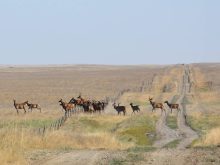Quick reflexes aren’t generally associated with field crops, but new research indicates barley combats disease invaders within as little as five minutes of an attack.
The discovery gives researchers new information that they hope will lead to development of long-term durable plant resistance to disease.
Andy Kleinhofs, a plant geneticist and professor of crop and soil science at Washington State University, recently discovered barley’s quick response to stem rust spores. It’s a departure from traditional thinking that plants take awhile to marshal defenses against invaders and don’t initiate a response until penetrated by disease or fungus.
Read Also

Crop quality looks good this year across Prairies
Crop quality looks real good this year, with the exception of durum.
“That’s been kind of the dogma,” said Kleinhofs. “But the response within five minutes was pretty amazing to us. That was a complete surprise, a complete and pleasant surprise. We totally did not expect it.”
Improved understanding of plants’ defence mechanisms may allow scientists to manipulate them so pathogens can be rejected much sooner in the plants’ life cycle. For crops, that means quicker rejection of disease or fungus so more energy can go toward yield.
Kleinhofs has been working exclusively with barley and stem rust, but he hopes his team’s findings will be transferable to other crops. Because barley and wheat are closely related, the barley discovery might help researchers develop ways to fight Ug99, a wheat pathogen that is a major threat to global grain crops.
“Most of our wheat and barley plants are susceptible to that race, and so we certainly hope to look at that to see if what we have learned extends to Ug99 and whether that information can be exploited in some way to help stop that race from causing disease. I think the discovery we have made has potentially great implications, but it remains to be actually discovered how to use it.”
Denis Gaudet, a crop disease researcher with Agriculture Canada in Lethbridge, sees promise in the Washington discovery.
He is intrigued by the connection it has made between plants’ innate response to pathogens and their activation of disease resistance mechanisms.
Pathogens have wily ways to avoid a plant’s resistance genes, but it is more difficult for pathogens to combat a host’s innate and usually quicker response to attack.
“What they’ve done is basically identified a system that has many of the properties of the innate immune response, the very early detection system, but it also has a very specific interaction, which has properties similar to the R (resistance) gene reaction,” Gaudet said.
“It would really be a huge breakthrough if we could identify a system that works like the innate immune system and that could provide broad and durable resistance against a whole different series of plant pathogens.”
Kleinhofs said he chose barley and rust for his research because barley is simple in genetic terms, at least compared to other crops, and the rust genome has also been sequenced.
He began his work by cloning a resistance gene in barley, Rpg1, which increased understanding of how barley protects itself. He and his team discovered various proteins that activate the resistance gene, and in that process they documented “communication” between barley and stem rust spores.
“We do know for sure it’s happening. The mystery is exactly how it happens. That’s what we’re working on to try to figure out,” said Kleinhofs.
The discovery has focused his research more on the pathogen and less on the plant. He and his team want to know how the pathogen signals the plant so resistance is activated. That could guide them in genetic modification of plants to respond more quickly when threatened by fungus and disease.
Gaudet said the holy grail for researchers in this field is to understand plants’ recognition systems so they can be manipulated into more prolonged protection.
“The plant can protect itself. All plants can protect themselves. That’s not an issue. It’s the detection system that is the issue,” said Gaudet.
He described pathogen invasion and plant response as a dance in which the plant tries to recognize the pathogen and the pathogen tries to avoid recognition and work its way into the cells.
One is trying to outsmart the other. “I like to think of it as a symphony that’s
going on where there are many things occurring at different levels. Once we can break it down to the different instruments that are involved, then we can start playing our own tune.”

















